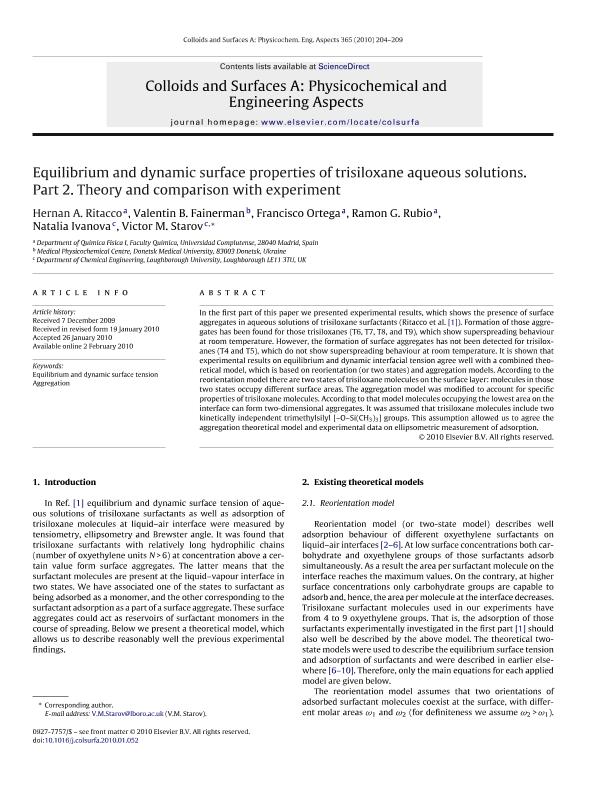Artículo
Equilibrium and dynamic surface properties of trisiloxane aqueous solutions. Part 2. Theory and comparison with experiment
Ritacco, Hernán Alejandro ; Fainerman, Valentin B.; Ortega, Francisco; Rubio, Ramon G.; Ivanova, Natalia; Starov, Victor M.
; Fainerman, Valentin B.; Ortega, Francisco; Rubio, Ramon G.; Ivanova, Natalia; Starov, Victor M.
 ; Fainerman, Valentin B.; Ortega, Francisco; Rubio, Ramon G.; Ivanova, Natalia; Starov, Victor M.
; Fainerman, Valentin B.; Ortega, Francisco; Rubio, Ramon G.; Ivanova, Natalia; Starov, Victor M.
Fecha de publicación:
12/2010
Editorial:
Elsevier Science
Revista:
Colloids and Surfaces A: Physicochemical and Engineering Aspects
ISSN:
0927-7757
Idioma:
Inglés
Tipo de recurso:
Artículo publicado
Clasificación temática:
Resumen
In the first part of this paper we presented experimental results, which shows the presence of surface aggregates in aqueous solutions of trisiloxane surfactants (Ritacco et al. [1]). Formation of those aggregates has been found for those trisiloxanes (T6, T7, T8, and T9), which show superspreading behaviour at room temperature. However, the formation of surface aggregates has not been detected for trisiloxanes (T4 and T5), which do not show superspreading behaviour at room temperature. It is shown that experimental results on equilibrium and dynamic interfacial tension agree well with a combined theoretical model, which is based on reorientation (or two states) and aggregation models. According to the reorientation model there are two states of trisiloxane molecules on the surface layer: molecules in those two states occupy different surface areas. The aggregation model was modified to account for specific properties of trisiloxane molecules. According to that model molecules occupying the lowest area on the interface can form two-dimensional aggregates. It was assumed that trisiloxane molecules include two kinetically independent trimethylsilyl [-O-Si(CH3)3] groups. This assumption allowed us to agree the aggregation theoretical model and experimental data on ellipsometric measurement of adsorption. © 2010 Elsevier B.V.
Palabras clave:
Aggregation
,
Equilibrium And Dynamic Surface Tension
Archivos asociados
Licencia
Identificadores
Colecciones
Articulos(IFISUR)
Articulos de INSTITUTO DE FISICA DEL SUR
Articulos de INSTITUTO DE FISICA DEL SUR
Citación
Ritacco, Hernán Alejandro; Fainerman, Valentin B.; Ortega, Francisco; Rubio, Ramon G.; Ivanova, Natalia; et al.; Equilibrium and dynamic surface properties of trisiloxane aqueous solutions. Part 2. Theory and comparison with experiment; Elsevier Science; Colloids and Surfaces A: Physicochemical and Engineering Aspects; 365; 1-3; 12-2010; 204-209
Compartir
Altmétricas



